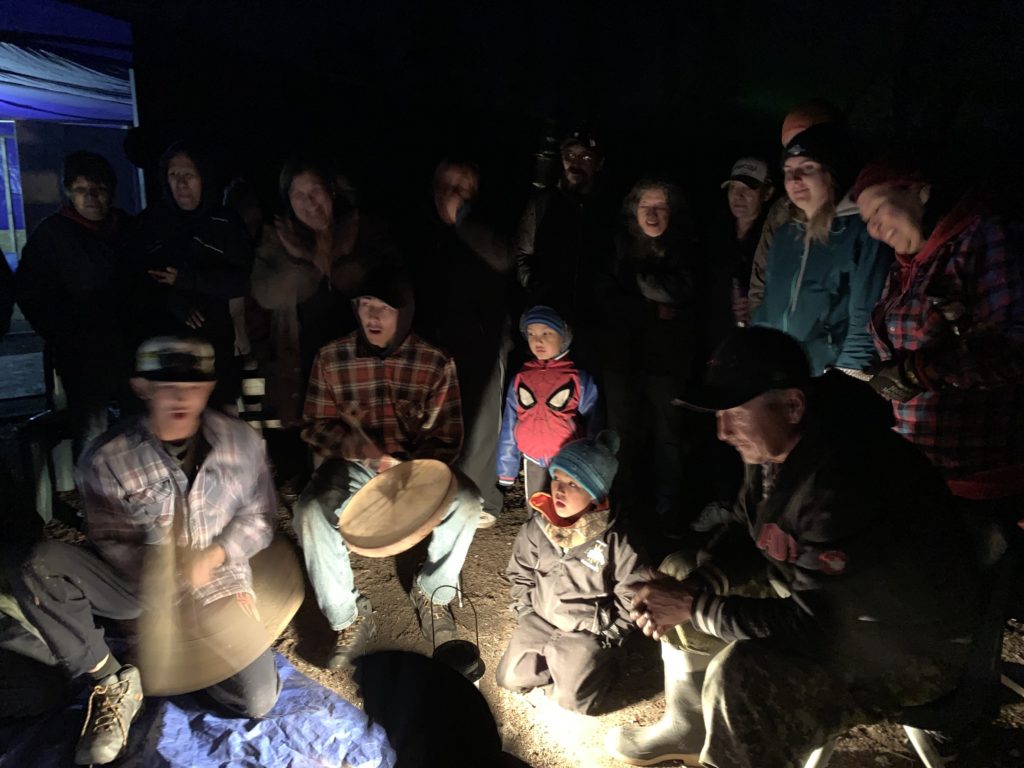
The sound of drums and laughter echoed across a rippling lake as a group of Dene, Cree and Inuit youth learned how to play traditional Dene hand games next to a crackling campfire.
A caribou hide hung nearby: earlier that day the youth were taught how to carefully scrape off the hair and prepare the hide for tanning.
“It was nice meeting new people — meeting Aboriginal people — and I’ve gained new friendships and learned a lot of new things,” said Kirsten Pameolik, who was among four youth from Arviat at the Tadoule Lake Stewardship Summit in September 2019. “I’ve learned that it’s important that we protect our land because this is where our ancestors survived and it’s important to keep our tradition or our culture alive.”
Indigenous Guardians
The week-long summit aimed to foster future leaders, teach valuable stewardship skills and connect Indigenous youth with traditional practices in order to lay the groundwork for an Indigenous Guardians program in the Seal River Watershed. Indigenous Guardians welcome visitors and act as stewards of the lands, waters and wildlife in an Indigenous Protected Area.
“Right now there is an opportunity to become trained and employed as Indigenous Guardians,” said Ron Thiessen, executive director of CPAWS Manitoba.
“What this summit is doing is providing some of that initial training and identifying people who’d like to do this as a job or a career: live off the land, welcome tourists, do science, Indigenous knowledge gathering, and help to take care of the landscape.”

Nicolas Duck (SDFN) Michelle Ewacha (CPAWS) Sandy Clipping (SDFN) and Casey Hyslop (SDFN) at the summit. (Credit: Mira Oberman, CPAWS)
Knowledge Gathering
The youth were introduced to water quality testing, fish monitoring, trail cameras and archeology. They also learned about the initiative to protect the Seal River Watershed and were granted teachings by elders of Sayisi Dene First Nation and the opportunity to practice hide tanning with Stephanie Thorassie.
“A project that requires the elders to teach the adults, and the adults to teach the youth about the traditional way of life – of cultural revival, and language revitalization, and a grasp of our history – is necessary if we want to live in balance within our territories, and united in cause with our neighbors,” said Ernie Bussidor, Executive Director of the Seal River Watershed Indigenous Protected Area Initiative.
“I’m sure that each and every one of us that are here will apply what we’ve learned here in our own communities and in our own ways,” said Rainer Duck, one of five youth from O-Pipon-Na-Piwin Cree Nation.
“The trees, the land the animals, it’s all connected and just so beautiful. It’s very important that we sustain that way of life for our future generations, for us to pass on that knowledge, and for them to protect what is rightfully ours.”
The youth from northern Manitoba and Nunavut were required to complete community volunteer service projects that engaged other youth through a peer-education model as part of the Canadian Wilderness Stewardship Program.
Those who completed the service projects were invited to Ottawa to share their experiences with youth from New Brunswick, Ontario and Quebec. The CPAWS program was funded by the Government of Canada under the Canada Service Corps program.
“It was great meeting other community members, different youth, learning new stuff,” said Roberta Tssessaze, one of four youth from Northlands Denesuline First Nation who attended the summit.

Community members and visitors to Sayisi Dene First Nation participate in hand games at the Tadoule Lake Stewardship Summit in September 2019 (Credit: Mira Oberman, CPAWS)
Warm Welcome
The visitors were welcomed warmly by Sayisi Dene First Nation. Many community members set up tents and joined the youth at the Twin Lakes campsite, which has long been used for gatherings. People took turns frying bannock over the fire, chopping wood and tidying the campsite while sharing stories and laughter.
“This is an opportunity to reinvigorate the Dene, the Cree and the Inuit cultures and share them with each other and with the world,” said Shaunna Morgan Siegers, operations manager for the Indigenous Leadership Initiative.
“The cultures are strong and young people are practicing their skills and traditions. They have knowledge to share. The elders are here and they’re sharing that knowledge. We have toddlers out here and they’re witnessing people caring for the caribou the way that their ancestors have always cared for it.”
